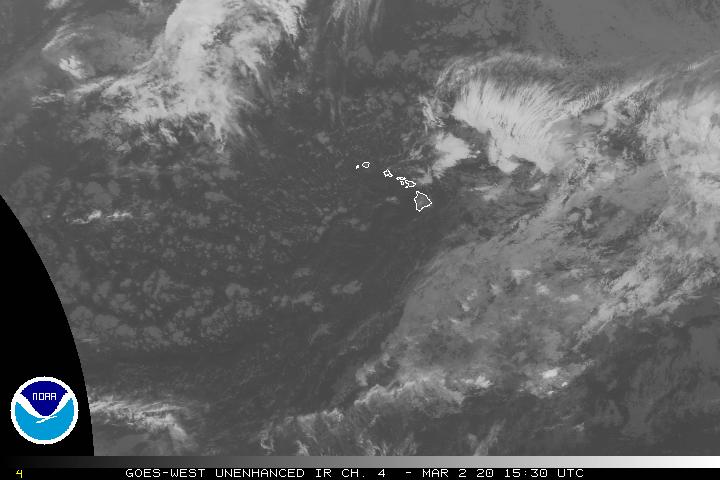Air Temperatures – The following high temperatures (F) were recorded across the state of Hawaii Wednesday…along with the low temperatures Wednesday:
87 – 77 Lihue, Kauai
87 – 76 Honolulu, Oahu
85 – 76 Molokai
89 – 75 Kahului AP, Maui
94 – 79 Kailua Kona
85 – 73 Hilo AP, Hawaii
Here are the latest 24-hour precipitation totals (inches) for each of the islands as of Wednesday evening:
0.07 Mount Waialeale, Kauai
0.02 Luluku, Oahu
0.00 Molokai
0.00 Lanai
0.00 Kahoolawe
0.01 West Wailuaiki, Maui
0.37 Saddle Quarry, Big Island
The following numbers represent the strongest wind gusts (mph) as of Wednesday evening:
30 Port Allen, Kauai
35 Oahu Forest NWR, Oahu
30 Molokai
35 Lanai
37 Kahoolawe
39 Maalaea Bay, Maui
42 Puu Mali, Big Island
Hawaii’s Mountains – Here’s a link to the live webcam on the summit of our tallest mountain Mauna Kea (nearly 13,800 feet high) on the Big Island of Hawaii. This webcam is available during the daylight hours here in the islands, and at night whenever there’s a big moon shining down. Also, at night you will be able to see the stars — and the sunrise and sunset too — depending upon weather conditions.
Aloha Paragraphs

Several cold fronts far north and northwest of the islands

Thunderstorms far southeast through southwest
Clear to partly cloudy…cloudy areas locally

Just a few showers – Looping radar image
Small Craft Advisory…windiest coasts and channels Oahu, Maui County and the Big Island
~~~ Hawaii Weather Narrative ~~~
Broad Brush Overview: Early summer trade winds, associated with high pressure north of the state, will continue through Thursday, before trending down by the weekend. Dry and stable conditions will limit shower activity over the state through Thursday, favoring windward and mountain areas. A slight increase in windward and mountain showers will be possible Friday through the weekend…as a weak upper disturbance moves into the area from the east.
Details: Models continue to show dry and stable conditions persisting through Thursday. The recent area of high clouds will shift west of the Kauai today. Atmospheric water values will remain around or slightly below average for this time of year. This will support below normal rainfall, favoring windward areas through the late night and early morning hours. Trade winds will remain breezy each day with locally strong gusts…especially during the afternoons.
Looking Further Ahead: The models go on to suggest an upper low, currently several hundred miles northeast of the Big Island, drifting towards the state. Moisture levels should increase to above average, in association with a weak surface trough…supporting a more active trade wind shower pattern. Meanwhile, the trade winds will weaken Saturday and Sunday, then strengthen with locally strong gusts…as high pressure remains north of the state early next week.
Here’s a wind profile of the Pacific Ocean – Closer view of the islands / Here’s the vog forecast animation / Here’s the latest weather map
Marine environment details: The Small Craft Advisory (SCA) includes the Kaiwi Channel, Maui windward waters, Oahu leeward waters, the typical windy areas around Maui County and the Big Island. The SCA is in effect through Thursday, and may continue into Friday, followed by slightly weaker trade winds this weekend.
The locally strong trades will produce choppy surf along east facing shores through the week. A small northwest swell is also forecast Friday into the weekend.
Small pulses of swell energy from the southeast through southwest will continue bringing near normal summertime surf along south facing shores. Reinforcing south swells will generate a slight increase in surf heights Thursday into the weekend.

Trade winds weakening by the weekend
>>> Southern California Weather Brief: Breezy winds are forecast in the mountains and deserts through Thursday night. The inland temperatures should be above normal into Saturday, then the high weakens. Onshore flow will develop into the weekend for an overnight marine layer which may spread into some valleys with temperatures below normal. A weak low will arrive over the holiday weekend and strengthen the onshore flow early next week for partly cloudy skies and further cooling. The high will return for a warmup by the middle of next week.
Longer range forecasts suggest the possibility of high pressure strengthening and covering much of the western third of the US. The location and orientation of the high are favorable for monsoon moisture to flow into southeast California…should a moisture source develop. In addition to a warming trend models also show a few small low pressure systems rotating through the area from the southeast, which could pose a threat for thunderstorm activity later next week into the weekend.

Low clouds offshore…which are extending inland
World-wide tropical cyclone activity
![]()
>>> Atlantic Ocean: No active tropical cyclones
No tropical cyclones are expected during the next 5-days
>>> Caribbean: No active tropical cyclone
No tropical cyclones are expected during the next 5-days
>>> Gulf of Mexico: No active tropical cyclones
No tropical cyclones are expected during the next 5-days
Here’s a satellite image of the Caribbean Sea…and the Gulf of Mexico
Here’s the link to the National Hurricane Center (NHC)
>>> Eastern Pacific: No active tropical cyclones
No tropical cyclones are expected during the next 5-days
Here’s a wide satellite image that covers the entire area between Mexico, out through the central Pacific…to the International Dateline.
Here’s the link to the National Hurricane Center (NHC)
>>> Central Pacific: No active tropical cyclones
No tropical cyclones are expected during the next 5-days
Here’s a link to the Central Pacific Hurricane Center (CPHC)
>>> Northwest Pacific Ocean: No active tropical cyclones
>>> North and South Indian Oceans / Arabian Sea: No active tropical cyclones
Here’s a link to the Joint Typhoon Warning Center (JTWC)
Interesting: Lake Superior: Facts About the Greatest Great Lake – Lake Superior is not only the largest of the Great Lakes; it is the largest body of fresh water on Earth. Situated on the northern edge of Wisconsin, Lake Superior extends from the upper peninsula of Michigan north to Ontario, Canada, and reaches west to the eastern edge of Minnesota. The name Superior refers to its size and also designates the lake’s position as the northernmost of all the Great Lakes.
The lake is about 160 miles wide and about 350 miles long. It has a surface area of 31,700 square miles and water volume of 2,900 cubic miles. The shoreline measures 2,726 miles, according to the Environmental Protection Agency (EPA).
How deep is Lake Superior?
The deepest point in Lake Superior is 1,300 feet below the surface, making a complete freeze a rarity. Lake Superior boasts extremely clear water, with an average underwater visibility of 27 feet. It takes almost 200 years for the lake to refill with new water, according to the University of Wisconsin.
Lake Superior water temperature
Like all of the Great Lakes, Lake Superior is prone to lake effect snow, but the weather is generally moderate, with warmer temperatures than inland throughout the year. Winter temperatures around the lake rarely fall below minus 30F, well above inland temperatures. June and July are calm months, while October and November are prone to storms.
During most winters, the lake is 40 to 95 percent covered with ice, although it rarely completely freezes. The last time Lake Superior froze over was in 2014. Overall, the Great Lakes reached a 91 percent ice cover that year, which is the most the lakes have frozen since 1979. Freezing of the lakes is monitored because it affects hydropower generation, commercial shipping, the fishing industry and more, according to the Office of Oceanic and Atmospheric Research.
The average water temperature is 40F — lower than the other Great Lakes, which are farther south. The water temperatures during the summer months average about 55F, but surface temperatures reached a record 68.7F in August 2010, and are affected by the amount of surface ice during the previous winter.
Formation and history
Lake Superior first took shape about 1.2 billion years ago as a result of the North American Mid-Continent Rift, which carved an arc-shaped scar stretching from Kansas through Minnesota. The first people to settle in the region arrived around 8000 B.C., after glaciers retreated, according to History of Lake Superior: A Timeline. By 500 B.C., Laurel people were trading for metal and other goods with different regions. By the early 1600s, the Ojibway people had established a village of several thousand on Madeline Island.
French explorers, including Samuel de Champlain (circa 1567-1635) and his scout, Étienne Brûlé (circa 1592-1632), arrived in the mid-1600s, according to the Canadian Museum of History.
The lake’s name comes from the French word lac supérieur, which means “upper lake.” It called this because it is north of Lake Huron, which was discovered first by Brûlé. The Objibways said that the lake was protected by Nanabijou, Spirit of the Deep Sea Water, according to the University of Wisconsin.
Superior was a major mode of transportation for the fur industry and other trading activities during the Colonial period and remains a shipping hub today.
Because of varying depths and unpredictable weather, Lake Superior and the other Great Lakes have been prone to maritime accidents. One of the most well-known incidents occurred on November 10, 1975, when the Edmund Fitzgerald, a large cargo ship carrying iron ore, encountered a severe storm that killed the ship’s 29 crew members.
Life on Lake Superior
Lake Superior is home to about 80 species of fish, including carp and varieties of trout, salmon and perch.
The Lake Superior region is also home to many common native plant species, including Michigan’s state tree, the white pine, and Flowering Rush, an aquatic plant that grows along the shoreline. Lake Superior’s basin is home to nearly 60 orchid species.
As with many lakes, Lake Superior is home to many species of birds, including varieties of hawks, loons, owls and woodpeckers. Duluth’s Hawk Ridge, which is on the lake’s north shore, hosts as many as 10,000 migrating birds of prey each day during the fall migration season.
There is a small population of endangered whooping cranes on the lake’s north shore, one of only two crane species in North America. As of 2017, there were only 483 individuals in the wild across North America, according to the International Union for Conservation of Nature.












 Email Glenn James:
Email Glenn James:
Shane Smart Says:
Either way that is HOT! It reminds me of being on Maui in late August 2015, when Kahului hit the record 97 (on the 22nd)….we were in town that day – with little breeze/high dewpoint, the heat index must have been well over 100! Regardless, definitely summer in the islands now, keep up the great work, I thoroughly enjoy this site!
~~~ Hot is right, I can only hope that the humidity levels weren’t sky high too! That would have made for a sultry plus day, like the one you describe in Kahului two summers ago.
Summer is here without a doubt, both on the calendar, and on the hot pavements!
So glad you enjoy this weather site, this pleases me!
Aloha, Glenn
Shane Smart Says:
Hi Glenn, WOW the heat was on in Kona with the 96 degree reading! What do you think pushed the temp that high in that area?
Shane
~~~ Hi Shane, wow is right, that was a very hot day in Kona! This 96 degree reading was reported on the NWS website, although I’m sort of waiting to see if it might have been a mistake, and of course would correct it on my site…if there was such a change.
Otherwise, I can only think that there was very little wind, with perhaps a downslope breeze from the nearby slopes. Additionally, the sun is now at near its highest point in the sky, and the days are some of the longest of the year…providing lots of time for the high temperatures to reach their utmost levels.
Thanks for your good question.
Aloha, Glenn